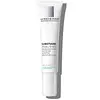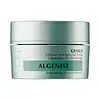What's inside
What's inside
 Key Ingredients
Key Ingredients

 Benefits
Benefits

 Concerns
Concerns

 Ingredients Side-by-side
Ingredients Side-by-side

Water
Skin ConditioningGlycerin
HumectantButyrospermum Parkii Butter
Skin ConditioningCyclohexasiloxane
EmollientPrunus Armeniaca Kernel Oil
MaskingPentaerythrityl Tetraethylhexanoate
EmollientIsohexadecane
EmollientZea Mays Starch
AbsorbentSilica
AbrasiveHydroxypropyl Tetrahydropyrantriol
Skin ConditioningCera Alba
EmollientStearic Acid
CleansingDimethicone
EmollientPalmitic Acid
EmollientPEG-100 Stearate
Glyceryl Stearate
EmollientPropylene Glycol
HumectantPEG-20 Stearate
EmulsifyingBis-PEG-18 Methyl Ether Dimethyl Silane
EmollientStearyl Alcohol
EmollientDimethiconol
EmollientArginine PCA
HumectantSerine
MaskingDisodium EDTA
Hydrolyzed Linseed Extract
Skin ConditioningAcetyl Dipeptide-1 Cetyl Ester
Skin ConditioningPolysorbate 80
EmulsifyingAcrylamide/Sodium Acryloyldimethyltaurate Copolymer
Emulsion StabilisingPentaerythrityl Tetra-Di-T-Butyl Hydroxyhydrocinnamate
AntioxidantSodium Benzoate
MaskingPhenoxyethanol
PreservativeBenzoic Acid
MaskingWater, Glycerin, Butyrospermum Parkii Butter, Cyclohexasiloxane, Prunus Armeniaca Kernel Oil, Pentaerythrityl Tetraethylhexanoate, Isohexadecane, Zea Mays Starch, Silica, Hydroxypropyl Tetrahydropyrantriol, Cera Alba, Stearic Acid, Dimethicone, Palmitic Acid, PEG-100 Stearate, Glyceryl Stearate, Propylene Glycol, PEG-20 Stearate, Bis-PEG-18 Methyl Ether Dimethyl Silane, Stearyl Alcohol, Dimethiconol, Arginine PCA, Serine, Disodium EDTA, Hydrolyzed Linseed Extract, Acetyl Dipeptide-1 Cetyl Ester, Polysorbate 80, Acrylamide/Sodium Acryloyldimethyltaurate Copolymer, Pentaerythrityl Tetra-Di-T-Butyl Hydroxyhydrocinnamate, Sodium Benzoate, Phenoxyethanol, Benzoic Acid
Water
Skin ConditioningCaprylic/Capric Triglyceride
MaskingGlycerin
HumectantButyrospermum Parkii Butter
Skin ConditioningHydrogenated Polyisobutene
EmollientChlorella Protothecoides Oil
EmollientDimethicone
EmollientGlyceryl Stearate
EmollientPEG-100 Stearate
Cetearyl Alcohol
EmollientCetyl Alcohol
EmollientPentylene Glycol
Skin ConditioningSilica
AbrasiveAlgae Exopolysaccharides
HumectantCollagen
MoisturisingAlgae Extract
EmollientPalmitoyl Oligopeptide
CleansingPalmitoyl Tetrapeptide-7
Skin ConditioningCopper Lysinate/Prolinate
Skin ConditioningMethylglucoside Phosphate
Skin ConditioningAlbizia Julibrissin Bark Extract
MaskingKigelia Africana Fruit Extract
Skin ConditioningPlantago Lanceolata Leaf Extract
AntimicrobialChrysin
Skin ConditioningDarutoside
Skin ConditioningSodium PCA
HumectantLeuconostoc/Radish Root Ferment Filtrate
AntimicrobialStearic Acid
CleansingCeteareth-20
CleansingCaprylyl Glycol
EmollientSteareth-20
CleansingAcrylates/C10-30 Alkyl Acrylate Crosspolymer
Emulsion StabilisingButylene Glycol
HumectantSodium Benzoate
MaskingPotassium Sorbate
PreservativeXanthan Gum
EmulsifyingChlorhexidine Digluconate
AntimicrobialN-Hydroxysuccinimide
Skin ConditioningChlorphenesin
AntimicrobialSodium Citrate
BufferingDisodium EDTA
Citric Acid
BufferingSodium Hydroxide
BufferingPhenoxyethanol
PreservativeWater, Caprylic/Capric Triglyceride, Glycerin, Butyrospermum Parkii Butter, Hydrogenated Polyisobutene, Chlorella Protothecoides Oil, Dimethicone, Glyceryl Stearate, PEG-100 Stearate, Cetearyl Alcohol, Cetyl Alcohol, Pentylene Glycol, Silica, Algae Exopolysaccharides, Collagen, Algae Extract, Palmitoyl Oligopeptide, Palmitoyl Tetrapeptide-7, Copper Lysinate/Prolinate, Methylglucoside Phosphate, Albizia Julibrissin Bark Extract, Kigelia Africana Fruit Extract, Plantago Lanceolata Leaf Extract, Chrysin, Darutoside, Sodium PCA, Leuconostoc/Radish Root Ferment Filtrate, Stearic Acid, Ceteareth-20, Caprylyl Glycol, Steareth-20, Acrylates/C10-30 Alkyl Acrylate Crosspolymer, Butylene Glycol, Sodium Benzoate, Potassium Sorbate, Xanthan Gum, Chlorhexidine Digluconate, N-Hydroxysuccinimide, Chlorphenesin, Sodium Citrate, Disodium EDTA, Citric Acid, Sodium Hydroxide, Phenoxyethanol
Ingredients Explained
These ingredients are found in both products.
Ingredients higher up in an ingredient list are typically present in a larger amount.
This ingredient is also known as shea butter. It is an effective skin hydrator and emollient.
Emollients help soothe and soften your skin. It does this by creating a protective film on your skin. This barrier helps trap moisture and keeps your skin hydrated. Emollients may be effective at treating dry or itchy skin.
Shea butter is rich in antioxidants. Antioxidants help fight free-radicals, or molecules that may harm the body. It is also full of fatty acids including stearic acid and linoleic acid. These acids help replenish the skin and keep skin moisturized.
While Shea Butter has an SPF rating of about 3-4, it is not a sunscreen replacement.
Shea butter may not be fungal acne safe. We recommend speaking with a professional if you have any concerns.
Learn more about Butyrospermum Parkii ButterDimethicone is a type of synthetic silicone created from natural materials such as quartz.
What it does:
Dimethicone comes in different viscosities:
Depending on the viscosity, dimethicone has different properties.
Ingredients lists don't always show which type is used, so we recommend reaching out to the brand if you have questions about the viscosity.
This ingredient is unlikely to cause irritation because it does not get absorbed into skin. However, people with silicone allergies should be careful about using this ingredient.
Note: Dimethicone may contribute to pilling. This is because it is not oil or water soluble, so pilling may occur when layered with products. When mixed with heavy oils in a formula, the outcome is also quite greasy.
Learn more about DimethiconeDisodium EDTA plays a role in making products more stable by aiding other preservatives.
It is a chelating agent, meaning it neutralizes metal ions that may be found in a product.
Disodium EDTA is a salt of edetic acid and is found to be safe in cosmetic ingredients.
Learn more about Disodium EDTAGlycerin is already naturally found in your skin. It helps moisturize and protect your skin.
A study from 2016 found glycerin to be more effective as a humectant than AHAs and hyaluronic acid.
As a humectant, it helps the skin stay hydrated by pulling moisture to your skin. The low molecular weight of glycerin allows it to pull moisture into the deeper layers of your skin.
Hydrated skin improves your skin barrier; Your skin barrier helps protect against irritants and bacteria.
Glycerin has also been found to have antimicrobial and antiviral properties. Due to these properties, glycerin is often used in wound and burn treatments.
In cosmetics, glycerin is usually derived from plants such as soybean or palm. However, it can also be sourced from animals, such as tallow or animal fat.
This ingredient is organic, colorless, odorless, and non-toxic.
Glycerin is the name for this ingredient in American English. British English uses Glycerol/Glycerine.
Learn more about GlycerinGlyceryl Stearate is a mix of glycerin and stearic acid.
It is used to stabilize the mixing of water and oil ingredients. By preventing these ingredients from separating, it can help elongate shelf life. It can also help thicken the product's texture.
As an emollient, it helps soften skin and supports barrier-replenishing ingredients.
In cosmetics, Glyceryl Stearate is often made from vegetable oils or synthetically produced.
This ingredient may not be fungal-acne safe
Fun fact: The human body also creates Glyceryl Stearate naturally.
Learn more about Glyceryl StearatePeg-100 Stearate is an emollient and emulsifier. As an emollient, it helps keep skin soft by trapping moisture in. On the other hand, emulsifiers help prevent oil and water from separating in a product.
PEGS are a hydrophilic polyether compound . There are 100 ethylene oxide monomers in Peg-100 Stearate. Peg-100 Stearate is polyethylene glycol ester of stearic acid.
Phenoxyethanol is a preservative that has germicide, antimicrobial, and aromatic properties. Studies show that phenoxyethanol can prevent microbial growth. By itself, it has a scent that is similar to that of a rose.
It's often used in formulations along with Caprylyl Glycol to preserve the shelf life of products.
Silica, also known as silicon dioxide, is a naturally occurring mineral. It is used as a fine, spherical, and porous powder in cosmetics.
Though it has exfoliant properties, the function of silica varies depending on the product.
The unique structure of silica enhances the spreadability and adds smoothness, making it a great texture enhancer.
It is also used as an active carrier, emulsifier, and mattifier due to its ability to absorb excess oil.
In some products, tiny microneedles called spicules are made from silica or hydrolyzed sponge. When you rub them in, they lightly polish away dead skin layers and enhance the penetration of active ingredients.
Learn more about SilicaSodium Benzoate is a preservative. It's used in both cosmetic and food products to inhibit the growth of mold and bacteria. It is typically produced synthetically.
Both the US FDA and EU Health Committee have approved the use of sodium benzoate. In the US, levels of 0.1% (of the total product) are allowed.
Sodium benzoate works as a preservative by inhibiting the growth of bacteria inside of cells. It prevents the cell from fermenting a type of sugar using an enzyme called phosphofructokinase.
It is the salt of benzoic acid. Foods containing sodium benzoate include soda, salad dressings, condiments, fruit juices, wines, and snack foods.
Studies for using ascorbic acid and sodium benzoate in cosmetics are lacking, especially in skincare routines with multiple steps.
We always recommend speaking with a professional, such as a dermatologist, if you have any concerns.
Learn more about Sodium BenzoateStearic Acid is a fatty acid. It is an emollient, emulsifier, and texture enhancer.
As an emollient, stearic acid helps soften skin. It aids the skin's protective barrier by preventing water loss. It also provides a gentle cleansing effect without stripping away natural oils.
Stearic acid may also be used to enhance the texture of products. It can add volume and stabilize ingredients such as water and oil. This can help water and oil ingredients from separating.
Sources of stearic acid include animal or vegetable fats/oils such as coconut or shea. It can be naturally found in butter, cocoa butter, shea butter, vegetable fats, and animal tallow.
This ingredient may not be Malassezia folliculitis, or fungal-acne safe.
Learn more about Stearic AcidWater. It's the most common cosmetic ingredient of all. You'll usually see it at the top of ingredient lists, meaning that it makes up the largest part of the product.
So why is it so popular? Water most often acts as a solvent - this means that it helps dissolve other ingredients into the formulation.
You'll also recognize water as that liquid we all need to stay alive. If you see this, drink a glass of water. Stay hydrated!
Learn more about Water